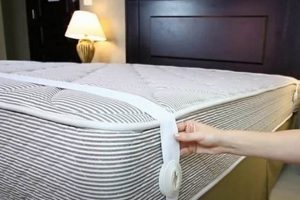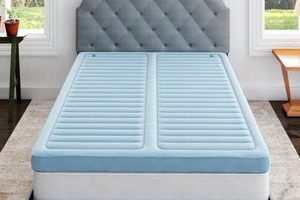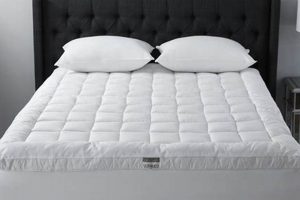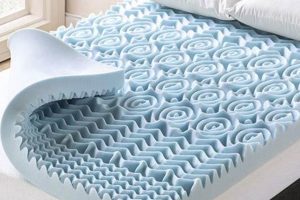Maintaining the position of an added layer on a bed is a common concern for individuals seeking enhanced comfort and support during sleep. When this layer shifts or moves, it can disrupt sleep quality and negate the intended benefits of the added cushioning. This article will explore various strategies to prevent this displacement, ensuring a stable and comfortable sleep surface. Consider a scenario where a memory foam layer is added to a traditional innerspring mattress to alleviate pressure points; preventing it from migrating across the bed is essential for consistent support.
Addressing the issue of a shifting bed layer is beneficial for several reasons. It promotes better sleep hygiene by maintaining a consistent sleep surface, reduces the need for nightly adjustments, and extends the lifespan of both the mattress and the added layer by preventing uneven wear. Historically, securing bedding has been a concern addressed through various methods, evolving from simple pinning to the use of elastic straps and specialized materials.
The following sections will delve into practical solutions, including the use of non-slip pads, specialized straps, fitted sheets designed for added depth, and techniques involving safety pins or hook-and-loop fasteners. Each method offers a unique approach to secure a mattress layer, catering to different mattress and layer types.
Practical Methods to Inhibit Mattress Layer Displacement
The following techniques outline proven methods for mitigating the unwanted movement of an added mattress layer, thus ensuring a stable and consistent sleep surface. Each suggestion provides a tangible solution to address the issue.
Tip 1: Implement a Non-Slip Pad: A non-slip pad, typically constructed from rubber or silicone, can be placed between the mattress and the added layer. The pad’s high-friction surface creates resistance, preventing slippage. This method is particularly effective for smooth mattress surfaces.
Tip 2: Utilize Mattress Straps or Suspenders: These straps, often adjustable, wrap around the mattress and over the added layer, securing it in place. Select straps with durable buckles or fasteners to ensure long-term reliability. This method is suitable for various mattress and added layer thicknesses.
Tip 3: Employ a Fitted Sheet with Deep Pockets: Opt for a fitted sheet designed to accommodate thicker mattresses or those with added layers. The deeper pockets provide a snug fit, which helps to hold the added layer in position. This solution works well for maintaining overall bed aesthetics.
Tip 4: Consider Hook-and-Loop Fasteners: Applying hook-and-loop fastener strips to both the mattress and the added layer can create a strong bond. Ensure the adhesive backing of the fasteners is suitable for fabric and will not damage either surface. This is a more permanent solution for significant displacement issues.
Tip 5: Safety Pins as a Temporary Solution: Strategically placed safety pins can temporarily secure the added layer to the mattress cover. Exercise caution when using this method to avoid damaging the fabric or causing discomfort during sleep. This is best suited for short-term fixes.
Tip 6: Anchor with Corner Bands: Elastic corner bands, similar to those used on fitted sheets, can be attached to the corners of the added layer and secured around the mattress corners. This approach focuses on stabilizing the corners, a common area for movement to initiate. Ensure the bands are of sufficient strength to maintain tension.
Tip 7: Mattress Encasement: Enclosing both the mattress and the added layer in a mattress encasement provides a comprehensive solution. The encasement acts as a single unit, preventing the added layer from shifting independently. Select an encasement made of breathable material to maintain comfort.
Implementing these methods reduces sleep disturbances, prolongs the lifespan of bedding components, and ensures consistent comfort. Each strategy contributes to a more restful and stable sleep environment.
The effectiveness of each method varies depending on the specific materials and circumstances involved, requiring careful assessment for optimal results.
1. Friction enhancement
Friction enhancement represents a fundamental strategy in mitigating mattress layer slippage. Increasing the frictional force between the mattress and the added layer directly opposes the forces causing displacement, thus maintaining the layer’s intended position.
- Material Selection
The choice of materials for both the mattress and the added layer significantly impacts friction. Materials with inherently higher coefficients of friction, such as rubber or silicone, provide increased resistance to movement. For example, placing a rubberized pad between a smooth memory foam layer and a slick mattress surface markedly reduces slippage.
- Surface Texture
Manipulating the surface texture of either the mattress or the added layer enhances friction. Roughened or textured surfaces interlock, creating mechanical resistance to lateral movement. Examples include mattress pads with textured undersides or mattress surfaces with embossed patterns designed to grip the added layer.
- Non-Slip Coatings
Application of non-slip coatings offers a targeted approach to friction enhancement. These coatings, typically composed of polymers, create a high-friction interface without significantly altering the texture or feel of the materials. Non-slip sprays or films can be applied to the underside of mattress layers to increase their adherence to the mattress.
- Pressure Distribution
While not directly increasing friction, optimizing pressure distribution contributes to stability. Uneven pressure concentration can exacerbate slippage. Using materials that evenly distribute weight across the surface reduces localized forces that might initiate movement. For example, a high-density foam topper distributes weight more uniformly than a less dense alternative, leading to improved stability.
Friction enhancement provides a practical and effective method for stabilizing mattress layers. By carefully considering material selection, surface texture, coatings, and pressure distribution, individuals can significantly reduce slippage, contributing to a more stable and comfortable sleep surface. The appropriate implementation of these strategies ensures the benefits of the added layer are consistently realized.
2. Securement mechanisms
The ability to inhibit mattress topper displacement relies significantly on the efficacy of implemented securement mechanisms. These mechanisms directly counteract the forces responsible for slippage, thereby maintaining the topp
ers position and ensuring a consistent sleep surface. Failure to adequately secure a mattress topper inevitably leads to unwanted movement, diminishing the benefits of the added layer and disrupting sleep. For instance, consider a memory foam topper placed on a platform bed; without appropriate securement, the friction from nightly movement will cause the topper to migrate, resulting in uneven support and potential discomfort. The choice and proper application of securement mechanisms are, therefore, crucial components of any strategy designed to prevent topper slippage.
Various securement mechanisms address the problem through different means. Elastic straps, for example, apply constant pressure around the mattress and topper, limiting lateral movement. Fitted sheets with deep pockets achieve a similar effect by providing a snug enclosure. Alternatively, hook-and-loop fasteners offer a more aggressive, semi-permanent solution, firmly bonding the topper to the mattress. The selection of a suitable mechanism hinges on several factors, including the type of mattress and topper materials, the severity of the slippage, and the desired level of permanence. In a household with active sleepers, more robust methods, such as straps or fasteners, would likely be necessary, while a fitted sheet may suffice for individuals who tend to remain relatively still during sleep.
In summary, securement mechanisms represent an indispensable aspect of preventing mattress topper slippage. Their purpose is to stabilize the topper against movement-inducing forces. The practical significance of understanding and correctly implementing these mechanisms lies in maintaining a comfortable and supportive sleep environment. Addressing the challenge of topper displacement is not simply about preventing a cosmetic annoyance; it is about ensuring the continued benefits of the added layer and promoting optimal sleep quality. While various solutions exist, careful assessment of individual needs and appropriate application of securement mechanisms are essential for achieving effective and long-lasting results.
3. Sheet compatibility
Sheet compatibility is a significant factor in maintaining the position of a mattress topper. The fit and material characteristics of bed sheets can either contribute to or mitigate the displacement of an added layer.
- Pocket Depth
Fitted sheet pocket depth is critical when a mattress topper is in use. Standard sheets may not adequately cover both the mattress and the topper, leading to a compromised fit. Sheets with deep pockets, specifically designed for thicker mattresses, provide a secure enclosure that minimizes movement. Inadequate pocket depth results in the sheet riding up and failing to hold the topper in place, directly contributing to slippage.
- Sheet Material
The material composition of the sheet influences its grip on the topper surface. Some fabrics, such as microfiber, are inherently smoother and may exacerbate slippage. Conversely, materials like cotton or flannel provide greater friction, aiding in keeping the topper in place. The texture and weave of the sheet interact with the topper’s surface, impacting its stability. Selecting a sheet material with sufficient texture can passively contribute to topper retention.
- Elastic Quality
The elastic band within a fitted sheet plays a vital role in maintaining tension and securing the sheet around the mattress and topper. Poor quality elastic loses its elasticity over time, resulting in a loose fit and increased potential for topper movement. A strong, durable elastic band ensures a snug and consistent fit, effectively preventing the sheet from slipping and taking the topper with it. The integrity of the elastic directly impacts the effectiveness of the sheet in containing the topper.
- Sheet Size Accuracy
Inaccurate sheet sizing, even within labeled dimensions, can undermine its ability to secure the topper. If the sheet is too large, it will be loose and ineffective at preventing movement. If it is too small, it may place undue stress on the seams and elastic, potentially leading to premature wear or tearing. Precise sheet sizing, matching the dimensions of the mattress and topper, is essential for optimal fit and functionality.
The interplay between pocket depth, material composition, elastic quality, and size accuracy determines the overall effectiveness of sheets in preventing mattress topper displacement. Selecting sheets specifically designed to accommodate the added height and considering material properties that enhance friction contribute to a stable and comfortable sleep surface.
4. Adhesive solutions
Adhesive solutions represent a direct intervention strategy in mitigating mattress topper displacement. The fundamental principle involves using a bonding agent to affix the topper to the mattress, thus preventing independent movement. The effectiveness of this approach hinges on selecting an appropriate adhesive and applying it correctly, while also considering the potential impact on the mattress and topper materials. When a mattress topper consistently migrates despite other preventative measures, carefully chosen adhesive solutions can provide a more permanent and reliable fix. For instance, a thin memory foam topper on a satin-covered mattress might require an adhesive to counteract their inherent slipperiness.
Several types of adhesives are available, each with varying degrees of strength and permanence. Temporary fabric adhesives, often in spray form, offer a less aggressive option suitable for preventing minor slippage. These adhesives provide sufficient tack to hold the topper in place but are designed to release relatively easily, minimizing the risk of damage during removal. Double-sided adhesive tapes, specifically designed for fabric applications, provide a stronger bond and can be strategically placed at the corners or along the edges of the topper. More permanent adhesive solutions, such as specialized fabric glues, offer the most robust bond but carry a greater risk of damage and should only be considered when other methods have failed. A practical application involves securing a latex topper to a bed base to prevent it from sliding off, thus ensuring uniform support and reducing potential injury. The long-term durability of this method needs periodic examination.
In conclusion, adhesive solutions offer a viable means of preventing mattress topper displacement, providing a more secure bond than friction-based methods alone. The successful implementation of this strategy requires careful selection of an adhesive appropriate for the materials involved and a thorough understanding of the trade-offs between bond strength and potential damage. While adhesive solutions can effectively address persistent slippage issues, they should be approached with caution and considered only after exploring other less permanent options. Addressing possible damage needs high consideration for implementing this solutions.
5. Corner stabilization
Corner stabilization constitutes a focused strategy within the broader effort to prevent mattress topper displacement. Given the inheren
t tendency for movement to initiate at the corners, reinforcing these areas provides a targeted approach to maintaining topper stability. Effective corner stabilization minimizes the likelihood of the entire topper shifting, thus preserving its intended position and benefits.
- Corner Band Application
The utilization of elastic corner bands represents a practical method of corner stabilization. These bands, typically affixed to the corners of the topper, loop around the corresponding mattress corners, creating tension that counteracts lateral movement. Their effectiveness hinges on the elasticity and durability of the band material. As a real-world example, consider a memory foam topper prone to sliding on a platform bed; corner bands can effectively anchor the corners, preventing the topper from migrating. The implications of this method include enhanced stability and reduced need for frequent readjustments.
- Corner Pocket Reinforcement
For toppers encased in fitted sheets, reinforcing the sheet’s corner pockets provides added stability. This can be achieved by using thicker elastic within the pockets or by adding supplementary fabric panels to increase friction. A scenario involves a deep-pocket sheet with reinforced corners used on a hybrid mattress; the reinforced pockets maintain a snug fit, preventing the corners of the topper from lifting and initiating slippage. This contributes to a more consistent and undisturbed sleep surface.
- Adhesive Corner Pads
Applying small, adhesive pads to the underside of the topper corners provides a localized bonding mechanism. These pads, typically constructed from non-slip materials, create a high-friction interface between the topper and the mattress. An example is the use of silicone pads affixed to the corners of a latex topper; these pads grip the mattress surface, minimizing corner movement. The use case contributes to minimized movement and long-term stability.
- Mattress Protector Integration
Selecting a mattress protector with enhanced corner anchoring systems contributes to overall stability. Some protectors feature integrated straps or reinforced corner pockets designed to secure the topper in place. For instance, a mattress protector with elastic corner straps used in conjunction with a gel-infused topper can significantly reduce the likelihood of corner-initiated movement. This integrated approach yields a more stable and uniform sleep surface.
The discussed facets highlight that corner stabilization offers a targeted and effective means of preventing mattress topper displacement. By implementing strategies that reinforce the topper’s corners, it is possible to significantly reduce the likelihood of slippage. This strategy, while focused on a specific area, has a significant impact on maintaining the overall stability of the sleep surface and preserving the intended benefits of the added layer.
6. Encasement method
The encasement method offers a comprehensive solution to mattress topper displacement by physically uniting the mattress and topper within a single, enclosed unit. This approach eliminates independent movement between the two components, thereby directly addressing the issue of slippage. The encasement acts as a barrier, preventing lateral movement and maintaining the topper’s intended position. This method is particularly effective when other strategies, such as straps or non-slip pads, prove insufficient, or when a more permanent solution is desired. For example, consider a scenario where a plush memory foam topper consistently migrates on a smooth, modern mattress; encasing both components creates a cohesive unit, restricting movement and ensuring uniform support.
Encasements typically feature zippered closures, fully encapsulating the mattress and topper. The material composition of the encasement influences its effectiveness. Breathable, waterproof fabrics are often preferred to protect against spills and maintain airflow. The snug fit of the encasement prevents the topper from shifting during sleep, regardless of movement. Furthermore, encasements offer additional benefits, such as protection against dust mites and allergens. Practically, this means fewer nightly adjustments and a more consistent sleep surface. They are available in a variety of sizes and materials to accommodate different mattress and topper dimensions. They offer more benefits aside the main topic, but maintaining their functions helps maintaning the topic to be discussed.
In summary, the encasement method provides a robust and effective solution to prevent mattress topper displacement. By physically joining the mattress and topper, it eliminates the root cause of slippage and ensures a stable and consistent sleep surface. While requiring a larger initial investment, the long-term benefits of enhanced stability, protection, and convenience make it a compelling option for individuals seeking a reliable solution. However, breathability, especially for long use, is the main consideration for choosing this solution.
7. Material interaction
Material interaction, specifically the physical properties and behaviors of the mattress and topper materials in contact, exerts a significant influence on the propensity for slippage. The coefficient of friction between these surfaces, dictated by their inherent composition and texture, directly determines the resistance to lateral movement. Dissimilar materials with vastly different surface characteristics will exhibit a greater tendency to slide against one another. Understanding these interactions forms a critical component in devising effective strategies to inhibit mattress topper displacement. If a smooth memory foam topper is placed atop a similarly smooth satin mattress, the minimal frictional force between these surfaces will inevitably lead to frequent slippage, necessitating intervention.
The selection of compatible materials offers a proactive approach to mitigating this issue. Combining materials with inherently higher coefficients of friction, such as a cotton topper on a textured mattress, reduces the likelihood of movement. Alternatively, the deliberate introduction of an intermediary layer with high frictional properties, such as a rubberized pad, can significantly enhance stability, irrespective of the mattress and topper materials. For instance, a latex topper, known for its inherent grip, may require minimal additional measures on a standard innerspring mattress, whereas a slick polyester topper would demand a more robust solution. The effect of temperature on material properties should not be discounted. Temperature-sensitive foams may soften and become more prone to shifting at higher temperatures.
In conclusion, material interaction stands as a foundational element in the challenge of preventing mattress topper slippage. By carefully considering the frictional properties of the materials in contact and selecting compatible combinations, individuals can significantly reduce the likelihood of displacement. While external securement methods offer viable solutions, addressing the underlying material interactions provides a more fundamental and potentially longer-lasting approach. Recognizing the connection between material characteristics and slippage is crucial for developing effective strategies to maintain a stable and comfortable sleep surface. The absence of this consideration can lead to a cyclical proble
m of persistent slippage.
Frequently Asked Questions
This section addresses common inquiries regarding the prevention of mattress topper slippage, providing concise and informative answers to assist in maintaining a stable sleep surface.
Question 1: What is the primary cause of mattress topper slippage?
The primary cause is insufficient friction between the mattress and the topper. Smooth surfaces and active movement during sleep contribute to the displacement.
Question 2: Are specific mattress topper materials more prone to sliding than others?
Yes, toppers made from materials like memory foam or polyester, with their smooth surfaces, tend to slide more readily compared to those made from cotton or latex.
Question 3: Can the type of mattress affect topper slippage?
Indeed. Mattresses with slick surfaces or those covered in satin-like fabrics increase the likelihood of topper movement. Textured mattress surfaces offer more resistance.
Question 4: How effective are mattress straps in preventing topper slippage?
Mattress straps, when properly installed and of sufficient quality, provide a reliable means of securing a topper, especially for active sleepers.
Question 5: Is a mattress encasement a worthwhile investment to prevent topper displacement?
A mattress encasement offers a comprehensive solution by physically uniting the mattress and topper, preventing independent movement and offering additional protection.
Question 6: Can the use of incorrect sheet sizes contribute to topper slippage?
Yes. Sheets that are too small can stretch and pull on the topper, while sheets that are too large fail to provide a snug fit, both of which can exacerbate slippage.
In summary, understanding the factors contributing to topper slippage and implementing appropriate preventative measures, such as utilizing high-friction materials, securement mechanisms, or mattress encasements, ensures a more stable and comfortable sleep environment.
The next section will delve into troubleshooting common issues encountered when attempting to prevent mattress topper displacement.
Conclusion
This exploration of “how to stop mattress topper from sliding” has delineated several practical strategies, ranging from friction enhancement and securement mechanisms to material selection and comprehensive encasement. The efficacy of each approach depends on specific circumstances, including mattress and topper materials, sleep habits, and desired levels of permanence. Successful mitigation of mattress topper slippage hinges on a thorough understanding of the underlying factors and the judicious application of appropriate solutions.
The persistence of mattress topper displacement not only diminishes the intended comfort and support but also necessitates frequent adjustments, disrupting sleep. Consistent implementation of the outlined methods will yield a more stable sleep surface, ensuring the long-term benefits of the added layer. Continued diligence in maintaining proper securement remains paramount for achieving uninterrupted rest.







